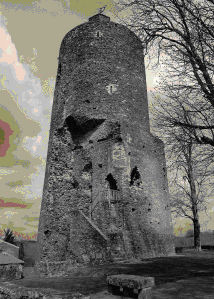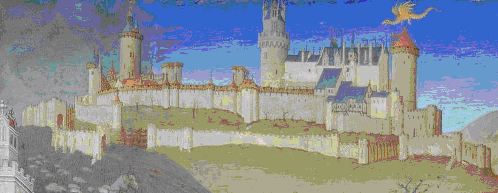Mélusine - Witch or Fairy
Home Page / Anne Golon Home / Book 1 / Hermes / Melusine
From : http://www.pantheon.org/areas/folklore/folktales/articles/melusine.html
The Story of Melusine (Medieval France, 1394)
by Linda Foubister
 The fairy, Melusine, was the daughter of the fairy Pressyne and King Elynas of Albany. She became the fairy Queen of the forest of Colombiers in the French region of Poitou. One day, she and two of her subjects were guarding their sacred fountain when a young man, Raymond of Poitiers, burst out of the forest. Melusine spent the night talking with Raymond, and by dawn, they were betrothed, but with one condition. Melusine requested that Raymond promise that he would never see her on a Saturday. He agreed, and they were married. Melusine brought her husband great wealth and prosperity. She built the fortress of Lusignan so quickly that it appeared to be made by magic. Over time, Melusine built many castles, fortresses, churches, towers and towns, each in a single night, throughout the region. She and Raymond had ten children, but each child was flawed. The eldest had one red eye and one blue eye, the next had an ear larger than the other, another had a lion’s foot growing from his cheek, and another had but one eye. The sixth son was known as Geoffrey-with-the-great tooth, as he had a very large tooth. In spite of the deformities, the children were strong, talented and loved throughout the land.
The fairy, Melusine, was the daughter of the fairy Pressyne and King Elynas of Albany. She became the fairy Queen of the forest of Colombiers in the French region of Poitou. One day, she and two of her subjects were guarding their sacred fountain when a young man, Raymond of Poitiers, burst out of the forest. Melusine spent the night talking with Raymond, and by dawn, they were betrothed, but with one condition. Melusine requested that Raymond promise that he would never see her on a Saturday. He agreed, and they were married. Melusine brought her husband great wealth and prosperity. She built the fortress of Lusignan so quickly that it appeared to be made by magic. Over time, Melusine built many castles, fortresses, churches, towers and towns, each in a single night, throughout the region. She and Raymond had ten children, but each child was flawed. The eldest had one red eye and one blue eye, the next had an ear larger than the other, another had a lion’s foot growing from his cheek, and another had but one eye. The sixth son was known as Geoffrey-with-the-great tooth, as he had a very large tooth. In spite of the deformities, the children were strong, talented and loved throughout the land.
One day, Raymond’s brother visited him and made Raymond very suspicious about the Saturday activities of his wife. So the next Saturday, Raymond sought his wife, finding her in her bath where he spied on her through a crack in the door. He was horrified to see that she had the body and tail of a serpent from her waist down. He said nothing until the day that their son, Geoffrey-with-the-great tooth, attacked a monastery and killed one hundred monks, including one of his brothers. Raymond accused Melusine of contaminating his line with her serpent nature, thus revealing that he had broken his promise to her.
As a result, Melusine turned into a fifteen-foot serpent, circled the castle three times, wailing piteously, and then flew away. She would return at night to visit her children, then vanish. Raymond was never happy again. Melusine appeared at the castle, wailing, whenever a count of Lusignan was about to die or a new one to be born. It was said that the noble line which originated with Melusine will reign until the end of the world. Her children included the King of Cyprus, the King of Armenia, the King of Bohemia, the Duke of Luxembourg, and the Lord of Lusignan.
Reference:
D’Arras, Jean. Melusine. Edited by A.K. Donald. London: Kegan Paul, Trench, Tribner & Co., 1895.
Published for the Early English Text Society, Extra Series 68. New York: Kraus Reprint Co., 1975.
From : http://legitbabenames.wordpress.com/2009/04/26/melusine/
Gender: Female Origin: French Meaning: uncertain
Pronunciation: French (may-luy-ZEEN); Eng (MEL-yoo-SEEN)
The name appears throughout European folklore as the name of a water sprite who turns into a serpent from the waist down each Saturday. She appears in several different folktales from the Middle Ages, one of the most famous legends being that of her marriage to Raymond of Poitou.
The Duke met the beautiful sprite in a forest. She married the duke on the condition that he never enter her bedroom on Saturdays.
Mélusine was known for her magical powers, especially her rapid building of structures, it is said that whole towns and churches were built in a night, the tower in Vouvant being one of them. It was here where she spent her Saturdays.
 Raymond was suspicious, and went to go spy on her at the tower. While looking through a peephole in the walls, he observed that his wife had transformed into a half serpent half human being. Melusine caught his indiscretion, but forgave him.
Raymond was suspicious, and went to go spy on her at the tower. While looking through a peephole in the walls, he observed that his wife had transformed into a half serpent half human being. Melusine caught his indiscretion, but forgave him.
The duke and the fairy had 10 children, each child bearing a strange physical characteristic. One of whom was Gregory Longtooth, who had massacred a monastary. Out of anger of his son’s actions, Raymond accused his wife of being a demon, and that she had infected his whole royal line with demon spawn. In outrage, Mélusine transformed herself into a dragon, drove through the castle’s walls, never to be seen again. However, she would continue to visit her ancestors right before someone would die, to warn them of their deaths. It is said that several royal lines throughout Europe are descended from her.
In German legends, she was known as Melusina, and the famed Christian Reformer, Martin Luther, often referred to her existence, believing that she was possibly a succubus. She even appears in the writings of Goethe. Some folktales insisted that Melusine was the fairy responsible for changelings.
The name was borne by Ehrengard Melusine von der Schulenburg, Duchess of Kendal and Munster, Mistress of George I of Great Britain, she went by and was known by her middle name circa (1667); and had one daughter by the name of Melusina (1693–1778).
The name Mélusine has made it into the Czech lexicon as meluzina, referring to a wailing wind that makes itself known in chimneys.
In popular culture, she is the famous mermaid of Starbucks.
In the Middle Ages, Melusine had many associations, some good and some bad. The great Queen Eleanor of Aquitaine was associated with the fairy as she came from the same line as Raymond of Poitou.
The name is of uncertain meaning, but in her book, Women of the Celts, Jean Markale, suggests that the name may be a derivative of the Latin Mal Lucina, meaning “evil Lucina,” arguing that Melusine was a personification of the goddess Juno/Lucina’s darker side. Some historians insist that Melusine was an ancient divinity who survived in folklore as a fairy.
Another theory is that Melusine is a derivative of the French term Mère Lusigne meaning “mother of the Lusignans.” Lusignan was the line of Raymond of Poitou.
Other sources suggest that it is of Breton origins, either meaning “marvellous” or “sea-fog.”
Possible nickname options include Melsie, Melzy, Mel, Lucy, Luce, Lucine and Sina
Mélusine, crusade, and Burgundian engagement with the East during the long fifteenth century
Dr Tania Colwell, School of History, ANU

The legend of Mélusine, the fairy serpent who establishes the illustrious dynasty of Lusignan, is intimately associated with Poitou in central France. The tale of a heroine who creates a dynastic empire and whose sons acquire fame and fortune on crusade in the east enjoyed enormous success across France, with over thirty manuscripts and seven printed editions of the Mélusine romances surviving from the fifteenth century alone. The romances were particularly popular in northern France and the Burgundian Netherlands, with around one third of the extant manuscripts having been produced for, or owned by, members of the ducal Burgundian court.
Much of the scholarly literature on the Mélusine romances has focused on the heroine’s fairy nature, with little attention directed towards the pseudo-historical narrative of the Lusignan sons’ crusading adventures and dynastic expansion into the eastern Mediterranean. This paper examines the place of the Poitevin tale within Burgundian court culture by analysing a selection of literary, historical, and artistic representations of the Lusignan romance. By contextualising the various representations of the legend against the socio-political interests and experiences shared by members of the Burgundian court across the period, this paper highlights how the theme of western engagement with the east consistently informed or shaped individual and/or collective reception of the Mélusine tale.
Page refreshed : 16th August 2017